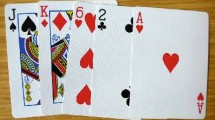Abstract
Three schemes for shuffling a deck ofn cards are studied, each involving a random choice from [n]n. The shuffles favor some permutations over others sincen! does not dividen n. The probabilities that the shuffles lead to some simple permutations, for instance cycles left and right and the identity, are calculated. Some inequalities are obtained which lead to information about the least and most likely permutations. Numbers of combinatorial interest occur, notably the Catalan numbers and the Bell numbers.
Similar content being viewed by others
References
Comtet, L.,Advanced combinatorics. D. Reidel, Boston, 1974.
Grossman, J. W.,Problem E2645. Amer. Math. Monthly84 (1977), 217.
Knuth, D.,The art of computer programming. Addison Wesley, Reading, Vol. 2, 1969, Vol. 3, 1973.
Lovász, L.,Combinatorial problems and exercises. North-Holland, New York, 1979.
Author information
Authors and Affiliations
Rights and permissions
About this article
Cite this article
Robbins, D.P., Bolker, E.D. The bias of three pseudo-random shuffles. Aeq. Math. 22, 268–292 (1981). https://doi.org/10.1007/BF02190184
Received:
Revised:
Issue Date:
DOI: https://doi.org/10.1007/BF02190184




